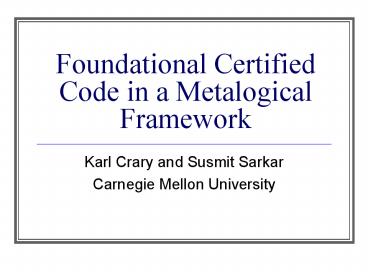Foundational Certified Code in a Metalogical Framework - PowerPoint PPT Presentation
1 / 29
Title:
Foundational Certified Code in a Metalogical Framework
Description:
Foundational Certified Code in a Metalogical Framework. Karl Crary and Susmit Sarkar ... Computer owners download and execute code from developers ... – PowerPoint PPT presentation
Number of Views:44
Avg rating:3.0/5.0
Title: Foundational Certified Code in a Metalogical Framework
1
Foundational Certified Code in a Metalogical
Framework
- Karl Crary and Susmit Sarkar
- Carnegie Mellon University
2
Motivation Grid Computing
- Make use of idle computing cycles over the
network e.g. SETI - Computer owners download and execute code from
developers - A key issue Unknown developers, so consumers are
concerned about safety
3
Certified code
Code is safe!
- Package the code with certificate PCC, TAL
- Certificate a machine verifiable proof of safety
- Typically, proof that code is well-typed in a
safe type system
Is code safe ?
Knowledge
Certificate
Developer
Consumer
Code
4
Type System? Is that safe?
- Old Answer Fix a type system, trust peer-review
- New Answer Give developers flexibility of using
their own type systems - Need to check this is safe
- Known as Foundational Certified Code
Type System
Type System
Machine details
Certificate
Developer
Consumer
Code
5
Roadmap
- Our system
- Metalogics
- Safety Policy
- A Safety Proof
- Related and future work
6
Our System
Safety Policy
Safety Condition
Safety Proof
Does Code satisfy the Safety Policy?
Why is your safety condition any good?
Certificate
Code satisfies my Safety Condition
I can prove it to you!
Developer
Code
Consumer
7
Metalogic meta theorems
- We use LF to express logics
- e.g., operational semantics
- producers safety conditions
- We care about meta theorems
- If some input derivation exists, then an output
derivation exists - e.g., Safety Theorem
8
How to check meta theorems?
- Choice 1 reflect metalogical reasoning in the
framework - Choice 2 use a logic designed for metalogical
reasoning - e.g. Twelf Schurmann
9
Programming in Meta logics
- We write logic programs relating derivations
- limited to ?-1 reasoning, authors plan stronger
system - Need to do induction on structure of derivation
- System can check these logic programs are total
(user annotations required)
10
Roadmap
- Our system
- Metalogics
- Safety policy
- A safety proof
- Related and future work
11
Safety policy - Preliminaries
- Formalize operational semantics of the IA32
architecture - Formalize machine states memory, register files,
stack, instruction pointer - Formalize transitions from state to state
- Remove transitions deemed unsafe
12
Example transition for addition
- addl 5,(eax)
- load 4 bytes from (eax),
- load immediate operand 5,
- add them,
- store result back in (eax),
- update EFLAGS and advance EIP
- This can go wrong, e.g. if eax points to
protected memory - Solution The formal load and store relations do
not apply in such cases
13
Safety Policy
- Define initial state on loading program P
- We never get to a state where the (formal)
machine does not have a transition - Another way of stating the formal machine is
never stuck - Halt state treated specially
14
Why is this safe?
- Real machines transitions according to formal
machines transitions real machine is performing
safe operations - To perform unsafe operations, real machine takes
a transition not in formal machine - This does not happen in a safe machine
15
Roadmap
- Our system
- Metalogics
- Safety policy
- A safety proof
- Related and future work
16
Example Safety Proof
- A particular safety proof
- Our safety proof is for TALT Crary
- Type system for an assembly language
- Fairly low-level, but still abstract
- Our foundational safety proof is syntactic Hamid
et al.
17
Safety
- Our conditions will isolate a set of safe states
- Safe states cannot transition to stuck states
Safe State M1
State M2
18
Key Lemmas
- Progress
- Preservation
Safe State M1
State M2
Safe
State M2
Safe State M1
19
Putting it together Safety Theorem
- Transitions from a safe state cannot go to a
stuck state
Safe
Safe State M1
State M2
20
Idea of proof
- Safe machine
- Three parts of the proof
- Abstract Type Safety (previous work)
- Simulation
- Determinism
Typed abstract M
implements
Safe State M
21
TALT safety proof Crary
- This has two top level lemmas
- Progress A well typed abstract machine makes a
transition - Preservation If a well typed abstract machine
makes a transition, the resulting (abstract)
machine is well typed
22
Concrete Machine Lemmas
- Simulation
- Determinism
Abstract M2
Abstract M1
Concrete M1
Concrete M2
Concrete M2
Concrete M1
Concrete M2
23
Progress
progress
Abstract M2
Abstract, typed M1
implements
implements
Safe State M1
State M2
State M2
24
Preservation
progress
Typed
Abstract M2
Typed abstract M1
implements
implements
implements
M2
Safe State M1
State M2
Safe
Safe
25
Implementation Statistics
- Safety Policy 2,081 lines of code
- Safety Proof 44,827 lines of code
- Time to check 75 sec
- Number of lemmas 1,466
- Man years 1 and 1/2
26
Related work
- Foundational PCC - Appel et al
- FTAL - Hamid et al
- Temporal Logic PCC - Bernard and Lee
27
Future Work
- Develop a compiler from Standard ML to TALT
- Expand the target language to include many more
IA32 instructions - Specify and prove other properties, e.g. Running
time bounds
28
(No Transcript)
29
Indeterminism
- The data may be indeterminate, due to e.g. input
- Safety demands that any instance be safe
- We have an oracle that the semantics consults to
determine what to do - Oracle is quantified in safety theorem































